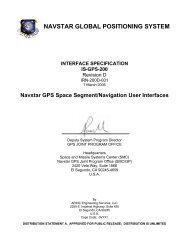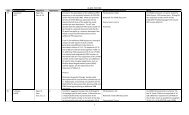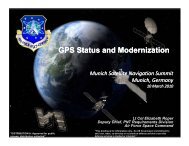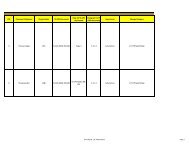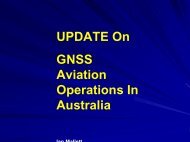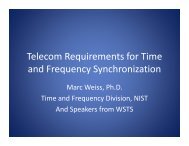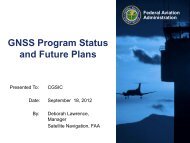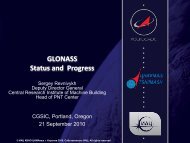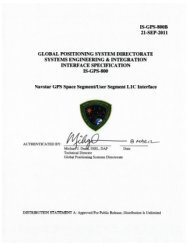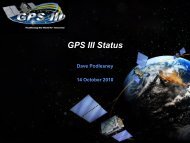Precise Positioning Service Performance Standard - GPS.gov
Precise Positioning Service Performance Standard - GPS.gov
Precise Positioning Service Performance Standard - GPS.gov
Create successful ePaper yourself
Turn your PDF publications into a flip-book with our unique Google optimized e-Paper software.
February 2007<br />
<strong>GPS</strong> PPS PS<br />
2.4 Usage Assumptions for PPS <strong>Performance</strong> <strong>Standard</strong>s<br />
This PPS PS is conditioned upon certain assumptions regarding use of the PPS SIS. Those<br />
assumptions are as follows.<br />
2.4.1 Authorized User<br />
This PPS PS assumes an authorized user with a keyed <strong>GPS</strong> receiver. Specifically, the <strong>GPS</strong><br />
receiver is assumed to contain current valid PPS keys and have the requisite hardware/software<br />
capabilities to be able to properly use those PPS keys.<br />
This PPS PS assumes the keyed <strong>GPS</strong> receiver complies with the technical requirements related to<br />
the interface between the Space Segment and PPS receivers as established by IS-<strong>GPS</strong>-200, ICD-<br />
<strong>GPS</strong>-224, and ICD-<strong>GPS</strong>-225 as appropriate.<br />
2.4.2 P(Y)-Code<br />
This PPS PS assumes the <strong>GPS</strong> receiver is tracking and using the Y-code signals transmitted by<br />
the satellites for best PVT solution purposes. If a satellite is transmitting P-code signals instead of<br />
Y-code signals, then this PPS PS assumes the <strong>GPS</strong> receiver will track and use the P-code signals<br />
transmitted by that satellite for PVT solution purposes and will use other means to guard against<br />
spoofing. This PPS PS assumes certain keyed <strong>GPS</strong> receivers may track and use the C/A-code<br />
signals transmitted by the satellites rather than the P(Y)-code signals for operational reasons.<br />
2.4.3 Dual- vs. Single-Frequency Operation<br />
This PPS PS assumes a keyed <strong>GPS</strong> receiver, which has the hardware capability to track and use<br />
the P(Y)-code signals transmitted by the satellites on L1 and on L2, will track and use both signals<br />
for dual-frequency measurement-based ionospheric delay compensation purposes. This PPS PS<br />
assumes that a <strong>GPS</strong> receiver which only has the hardware capability to track and use the P(Y)-<br />
code signals transmitted by the satellites on L1 will track and use that signal for PVT solution<br />
purposes and the receiver will use the satellite-transmitted ionospheric parameters for singlefrequency<br />
model-based ionospheric delay compensation purposes. This PPS PS further assumes<br />
that certain dual-frequency <strong>GPS</strong> receivers may only track and use the P(Y)-code signals<br />
transmitted by the satellites on L1 or on L2, and correspondingly use the satellite-transmitted<br />
ionospheric parameters for single-frequency model-based ionospheric delay compensation, for<br />
operational reasons.<br />
Since Navstar satellites may suffer failures which prevent them from transmitting on both L1 and L2<br />
(i.e., a satellite which transmits L1 only or L2 only), this PPS PS assumes a <strong>GPS</strong> receiver will track<br />
and use such an L1-only satellite or L2-only satellite as necessary for operational reasons. When a<br />
<strong>GPS</strong> receiver tracks and uses a particular L1-only satellite or L2-only satellite, this PPS PS<br />
assumes the <strong>GPS</strong> receiver will use the satellite-transmitted ionospheric parameters for singlefrequency<br />
model-based ionospheric delay compensation of that particular satellite’s signals.<br />
This PPS PS assumes a <strong>GPS</strong> receiver will take the inaccuracies of dual-frequency measurementbased<br />
ionospheric delay compensation and single-frequency model-based ionospheric delay<br />
compensation into account during operations.<br />
1 st Edition Page 14



